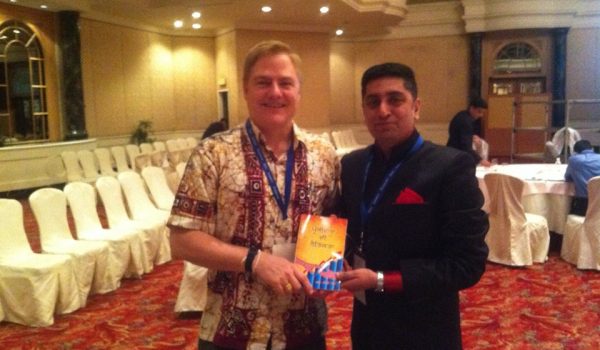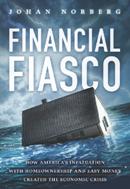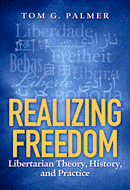Among the many books I read during my recent travels, I strongly recommend Johan Norberg’s truly excellent diagnosis of (and prescriptions for) the financial crisis: Financial Fiasco: How America’s Infatuation with Homeownership and Easy Money Created the Economic Crisis. It’s far better than the other works I’ve read, not only because Norberg is a smart guy, a meticulous researcher, and a good writer, but because it’s an exercise in economic analysis and financial journalism, with no religion thrown in. (As an example of the latter, the book Meltdown by Thomas Woods insists, contrary to the evidence, that the artificially induced boom resulted in a lengthening of the capital structure through overinvestment in too many “long-term projects.” [p. 68] In fact, what we saw was a bubble in housing, which is not a “long-term project” that will “bear fruit only in the distant future,” but a speculative investment in a durable consumer good, with an additional twist: the low refinancing rates and the inducements to refinance led many to treat their homes as ATM machines and withdraw cash to finance, not “long-term projects,” but consumption. But Mises and Hayek explained a previous boom-and-bust cycle in terms of a lengthening of the capital structure, so we must believe — we must, a priori! — that all boom-and-bust cycles must — they must! — follow the same process. That’s religion, not analysis. Woods embeds some information on the deliberately induced housing bubble and the policies of Fannie Mae, Freddie Mac, etc. in a populistic treatment of the crisis; setting aside the religion, it’s ok, but it does not compare well with the much more rigorous and financially sophisticated treatment offered by Norberg.)
Norberg’s book is outstanding. I encourage people to buy it, read it, and recommend it. (I also recommend the writings of John Cochrane of the University of Chicago; this interview of Cochrane by Russell Roberts is a good place to start.)
Lastly….a quick plug for Realizing Freedom: Libertarian Theory, History, and Practice, which contains some essays (e.g., “The Role of Institutions and Law in Economic Development,” “Twenty Myths About Markets,” “Infrastructure: Public or Private”) that may help to make sense of complex economic and political phenomena. At least, John Stossel (then of ABC News) thought so:
“Tom Palmer has the ability to make the complex understandable and to go to the heart of the most difficult problems. He is a valuable resource for journalists and others in search of historical and economic scholarship and philosophical insight, especially about the impact of government intervention and the reasons for respecting the freedom and responsibility of individuals.”












I ordered Financial Fiasco just now from Amazon. Thanks for the tip.
I read the Woods book, too. What do you think accounts for the religious treatment of what one would think ought to be treated as empirically verifiable accounts? I know the general take that they have on the relationship between theory and history, but I do not understand how that can lead to such serious errors of interpretation.
“Thomas Woods insists, contrary to the evidence, that the artificially induced boom resulted in a lengthening of the capital structure through overinvestment in too many “long-term projects.””
Mr. Palmer, are you just accusing Tom Woods of sloppy wording, or are you saying he is actually wrong for thinking the housing boom constituted a lengthening of the structure of production (in Austrian terminology)? You agree that interest rates affect home prices more than haircut prices, right? Is that because housing is more long-term than haircuts, or because a bunch of bishops have infiltrated the real estate market?
I think that building a house is a long term project, involving housing services at least thirty and perhaps very many more years in the future. Of course, they provide services in the near future as well. If you make a new house more durable, then you are adding resources now in order to get more services in the future.
On the other hand, the point about using the homes as ATM machines does cast doubt on the notion that there was a shift from consumer goods to capital goods.
It looks like you hit a nerve: http://www.lewrockwell.com/blog/lewrw/archives/41809.html#more-41809
I don’t have my copies of either the Norberg book or the Woods book with me at the moment, so a more detailed response will have to wait until tomorrow. Nor do I have my sacred texts to pore over for the right revelation/explanation/prediction of all possible boom-and-bust cycles. My recollection, however, is that the theory applied by several scholars to previous boom-and-bust cycles was that an increase in credit through a lowering of the central bank’s interest rate sent a signal to producers that there was a change in the valuation of present vs. future consumption, inducing investors to “lengthen” the structure of production, investing more in capital goods that will generate consumption goods in future. That entailed a shift of production away from making consumer goods to making capital goods, i.e., intermediate goods that are used to produce goods (that may be used to produce goods that may be used to produce goods) that are the objects of consumption. I don’t think that there’s much evidence that that happened. We got a lot of cheap easy credit thrown at us and we used it to buy cool consumer goods, including bigger and more expensive houses. We didn’t use the bigness of the houses to produce other goods; we just consumed it. The fact that they’re durable doesn’t make them higher order capital goods. And we shifted from renting houses/apartments to buying them. FHA, Fannie Mae, Freddie Mac and all the rest pushed and pushed and pushed to lower bank lending standards and get that extra percentage point to shift from renting to buying and…….it turned out there were reasons that the people in that marginal percentile were not owners and when they were induced to make the shift, it turned out that there were unintended consequences. (A number of people also bought second homes as speculative investments.) Moreover, the huge rate of housing refinancing meant that an awful lot of money was “taken out” of home equity and turned into vacations and home improvements (again, not investments any more than getting my clothes dry cleaned or getting a haircut is an investment). A lot of credit was funneled through home loan refinancing into consumption. So what we saw was a lot of new credit that was funneled into buying big ticket consumption items, shifting people from renting to buying, and using mortgage refinancing to fund consumption. It’s traceable to the effects of cheap credit, to be sure, but just not in the way that Woods asserts. He did a cut-and-paste job with Hayek’s theory (from “Monetary Theory and the Trade Cycle” and “Prices and Production”), without thinking about it, because….hey, the “Austrian” case (never mind that there may be many “Austrian cases”) has gotta be right.
As Anna Schwartz notes, without endorsing a view of overinvestment in capital goods,
http://online.wsj.com/article/SB122428279231046053.html
There’s no need to insist that there are more and more stages in the production process or that people are investing in more higher order goods to make that point. The invocation of the “Austrian theory” in that form was not a necessary part of the explanation. Some suitably altered formulation (which I don’t recall him offering in his book) may do the trick, but I’m old-fashioned enough to wonder how many epicycles we need to add to a theory for it to be the “same theory.”
All that said, I compared Wood’s book to a better book. I’ve read both. I found one to be much better and more sophisticated. Go and read them both and make up your own minds.
Bill Woolsey–Is there any evidence that should lead us to think that houses were made more durable because of the housing bubble?
It’s an interesting conjecture, though.
Thanks, Tom, for sharing this, and for showing me the letter you got from Tom Woods. Wow.
Woods:
“I thought it was pretty juvenile of Tom Palmer to go out of his way to attack Meltdown, my New York Times bestseller on the economic crisis, on such juvenile and uncomprehending grounds.”
(It’s “juvenile” to criticize a book, but not juvenile to write to the critics colleagues???)
And more Woods:
“If I am writing bestselling books, lecturing all over the world, being greeted by thunderous standing ovations (I have the YouTubes to prove it), getting six-figure advances, and earning the respect of Bob Higgs, Bettina Greaves, Judge Napolitano, Ron Paul, Larry Reed, and the rest of the non-DC libertarian world, why should I pause for a moment over Tom?”
If ever there were a case that those guys are in a cult, this proves it. One mild bit of criticism and they go bananas and denounce the critic.
Mo–o-o-m!!! He criticized my thesis! I’m telling! I’m telling! I’m telling! Waaaaaa…..
You even got a tantrum from Kinsella, another Kult leader:
http://www.stephankinsella.com/2009/11/02/beltway-libertarians-and-the-bottom-billion/
If you don’t like an author’s conclusions, DON’T READ HIM!!! You have nothing to learn from an Oxford professor who favors bad policies. It will only poison your mind, dude.
This is making the rounds.
I’ve seen Tom Woods and his YouTubes are humongus! VaVaVoom!
Did you see this on Woods and the ‘League of the South’? http://rightwatch.tblog.com/post/1969853923
I have no reason to believe that the more expensive houses were more durable. Maybe there were just bigger.
I am no expert on Hayek. And I don’t think the Austrian account has much to offer in explaining the Great Recession.
Still, I do recollect Hayek explaining how producing durable capital goods involve provision for the more distant future. Perhaps in a Pure Theory of Capital. It isn’t always the choice between planting corn and redwood trees.
Suppose all homes were rented, and because of low interest rates, fewer house trailers are purchased by the real estate companies and more (durable) single family homes are built. This requires more resources now, and more alternative output must be sacrificed now. The stick built homes imply that the real estate firms will be able to provide more housing services in the future.
Both the trailers and the stick built homes allow housing services to be provided now. But replacement trailers will need to be produced to get housing services in the future. While the current stick built houses will provide the future services too.
If interest rates are low, and expected to remain low, perhaps the real estate management companies will purchase too many single family homes. If interest rates rise, they will regret that decision. The rents received will not cover the opportunity cost of the funds that were tied up in the house. They will purchase fewer new single family homes as the old ones wear out.
The fact that many people are home owners may be a little confounding. But still, durable consumer goods (even cars and furniture) involve more round about methods of production.
The story isn’t too hard. Money creation causes interest rates to be too low. If people assume these low interest rates are permanent, they buy more homes (gettting both current and future consumption services.) When interest rates rise again, they purchase fewer new homes. There is a boom and then a bust in the home industry.
Not much of a speculative bubble in my opinion, but plausible enough.
Frankly, I would worry less about more and more stages of production in the malinvestment story. It is about how much resources are being devoted to the more distant future. There are many ways in which this can occur. More durable consumer goods count. I think.
Tom, Friedrich Hayek is very specific — he identifies houses as production goods, i.e. long term capital goods. See F. A. Hayek, _The Pure Theory of Capital_.
And note well: Hayek’s account of the ABCT does not even require the causal involvement of a central bank — private banks and investors can set the thing in action, creating bandwagon bubble effects across the time structure of the economy, etc. See _Monetary Theory and the Trade Cycle_.
And in a later version of the malinvestment / disequilibrium story, Hayek put profits at the center of the causal story, and not interest rates, and made essential reference to changing trade offs between labor and capital goods at different relative prices.
The malinvestment / disequilibrium story can be complex in many different causal / relative price / time dimensions, and Hayek was well aware of that.
Tom, you have even the simplest versions wrong. In even these simplest pedagogic versions who end up with simultaneously too much consumer consumption and too much long term capital investment — you are burning the candle at both ends, and you are not producing the equipment needed to replace those candles.
You write:
“My recollection [is] that an increase in credit through a lowering of the central bank’s interest rate sent a signal to producers that there was a change in the valuation of present vs. future consumption, inducing investors to “lengthen” the structure of production, investing more in capital goods that will generate consumption goods in future. That entailed a shift of production away from making consumer goods to making capital goods, i.e., intermediate goods that are used to produce goods (that may be used to produce goods that may be used to produce goods) that are the objects of consumption.”
Sorry for the delay, Greg. I’ve been busy all day (and still have a lot of work to do).
Thanks for the citation. I have my copy of “The Pure Theory of Capital” before me (plus “Monetary Theory and the Trade Cycle” and “Profits, Interest and Investment”), which I’ve not looked at in many years. (The former I never got entirely through, in any case.) Could you please provide page numbers? (The indexes are sparse.)
Should we distinguish between a speculative runup, or bubble, in housing prices and an increase in the stock of housing? A lot of the credit pushed into markets went into refinancing, which doesn’t increase the housing stock (but did allow a lot of people to shift credit card debt, the interest for which is not deductible, into mortgage debt, the interest for which is deductible), or a simple price bubble. For example, Randal O’Toole argues that we saw the biggest price increases in those areas where new housing was the most difficult to start, due to restrictions on new construction. As he noted,
http://www.cato.org/pubs/pas/pa646.pdf
In those areas with the biggest runup in prices and the biggest collapse, there wasn’t much new construction. It was credit bidding up the prices of already-existing housing stock. And it was people being induced to shift from renting to buying — with zero percent down, it’s hard to tell the difference, except for the way that the payments were financed and the loans were securitized, leaving banks, rather than specialized landlords, in charge of the properties when the tenants decided to stop paying and drop off the keys. So where is the lengthening or deepening (or whatever term we want to use) of the capital stock?
People who just assert that every economic cycle must be explainable by one theory, with one model, are not doing economic science. They’re chanting mantras.
That negative real interest rates for 2.5 years will induce people to borrow more is pretty clear. That that new money is going to bid up some prices is also pretty clear. (And we’re talking about relative prices; some inflation is hidden, or hard to detect, if it merely keeps nominal prices from falling.) But a bubble in prices is not the same as an increase in the depth or length of the capital stock. We saw a lot of consumer expenditure that was funded by new credit, much of it in the form of people taking out refinancing (I’m one of them) to pay off credit cards and finance consumption. And the response, when the dust settled, was for people to open their investment books, look around at the job market, and say, “Hmmmm…. maybe I oughta increase my savings and cut my expenses,” to which the politicians said, “No! Increase your expenditures and cut your savings to stimulate the economy.” We’ve had a mismatch between what people thought were the values of their assets and what they really were, with a correction. Ok. No need to go into detail about lengthening or deepening.
The very idea that people were encouraged to buy homes as “investments” is a clue to what was going on. Call me old-fashioned, but in a normal market economy, you buy your clothes to wear them and you buy your home to live in it. You don’t buy them as investments (unless you’re a specialized clothing or housing dealer), hoping that prices will keep going up and you can find someone else to “flip” them to. My suits are long-term durable goods because I take good care of them and they last a long time, unlike t-shirts. But they aren’t goods I “invest” in hoping to sell them later for higher prices. The same should go for homes. But the wash of cheap money made many of us speculators in homes, buying them in the hope that we could sell them later for a higher price. When interest rates went back up, that had to come to a halt and the bubble had to deflate.
Woods on pages 68 and 69 (I found my marked-up copy of the book) says that the bust happens when “The pool of real savings turns out to be smaller than entrepreneurs anticipated, and thus the complementary factors of production they need wind up being scarcer than they expected. The prices for these parts, labor, and other resources will therefore be higher than entrepreneurs expected, and business costs will rise. Firms will need to borrow more to finance these unanticipated increases in input prices. This increased demand for borrowing will raise the interest rate. Reality now begins to set in….” Etc. Is that what happened? Did a lot of half-finished housing projects stop because the prices of inputs rose higher than people expected? Is there evidence for that, or are there simpler explanations for the financial crisis, namely, that default rates on mortgages started to rise?
There’s no shame in the accounts of Mises or Hayek not fitting to a T this cycle. They’re theories, not holy writ. As more than one wag has pointed out, the more zealous “Austrians” have predicted 11 of the last four crises. I love the “Austrian” economists and have learned a lot from them. But I don’t want to “study Austrian economics”; I want to figure out how the world works, and if they can help, then I want their insights. But I don’t want to “study them.” The goal of “studying Austrian economics” is initiation into a dogma, a cult, a church. It is a disservice to the great intellects (Menger, Boehm-Bawerk, Wieser, Mises, Hayek, Kirzner, et al) whom we associate with that tradition.
But to get back to the issue at hand, I read a book I found really helpful and from which I learned: Johan Norberg’s Financial Fiasco. I shared that knowledge with others and I compared it with another book, which I called “ok,” minus the religion. But the religious dogmatics can’t stand the idea that one can be critical of what they see as one of their books, or think another book is better. (By the way, which of the people who is upset at the comparison has read both of them? My suspicion is that the answer is: not one. That is religion, not intellectual curiosity or openness.) Sure, read the Woods book. As I said, it’s ok, but too religious for my taste. But read Norberg, too, and you’ll see a first rate mind tackling a complex problem requiring informed explanations. And if you have time for only one, I think that Norberg’s book is by far superior. (And not only because it came out in English later; Norberg wrote it in Swedish and it had to be translated into English, so there was some delay there.)
Finally, writing letters to my colleagues to try to get me fired for comparing his book unfavorably to a much better book should tell you a lot about his attitude to scientific investigation and the life of the mind.
Tom, curious if you’ve read Thomas Sowell’s book, “The Housing Boom & Bust,” and if so, how does it favorably/unfavorably compare to Norberg’s?
I’m not a believer in ABCT, but Greg is right that in its normal form you have BOTH more investment in long-term capital goods and more consumer spending. If there were a legitimate shifting of time preferences there would be a simple shift from consumer to capital goods (or vice versa). The expansion of both at the same time without a genuine increase in resources indicates a sort of breaking of the Hayekian triangle.
Bryan Caplan’s critique of the ABCT is that it is durable goods which suffer in a recession, regardless of whether they are “capital” used for later stages of production.
Josh, I haven’t read it. Do you recommend it? (I just went to Amazon and it’s not going to be released until January. I’ve pre-ordered it.)
Tom, Hayek’s discussion of houses is in chapter 5 of _TPTofC_, see for example pages 77-78 of the _Collected Works_ edition, esp. at footnote 15.
You write:
“Thanks for the citation. I have my copy of “The Pure Theory of Capital” before me (plus “Monetary Theory and the Trade Cycle” and “Profits, Interest and Investment”), which I’ve not looked at in many years. (The former I never got entirely through, in any case.) Could you please provide page numbers? (The indexes are sparse.)”
Tom, let me assure you that in Orange County, CA there was a good deal of new construction in housing. I live in one of those new developments. There was a huge swing in the home construction business.
Strawman alert:
“People who just assert that every economic cycle must be explainable by one theory, with one model, are not doing economic science. They’re chanting mantras.”
And note well Tom, it’s your picture of the ABCT which is the thing that is fatally constricted. All Hayek was saying is that interest rates and profits will re-align the real structure and relative price of heterogeneous production processes and consumption and heterogeneous labor over time. No where did Hayek say that these relations couldn’t be quite different in different historical episodes — in fact, Hayek said exactly the opposite.
In real time BIS chief economists William White used Hayekian macro and the data on housing, derivatives, balance of payments, interest rates, etc. to lay out the case for an unsustainable Hayekian boom and inevitable bust — work White began publishing as early as 2003. Greenspan wouldn’t even look White in the eye when White explain what was happening to the world’s central bankers at a conference in 2003. White use more that just Hayekian macro to explain what was happening and what was going to happen, but Hayek’s macro was at the center of it all. I recommend White’s work to you, which is linked below:
http://hayekcenter.org/?p=1688
http://hayekcenter.org/?p=444
Can you tell me how it is a “disservice to the great intellects (Menger, Boehm-Bawerk, Wieser, Mises, Hayek, Kirzner, et al)” to encourage reading and teaching the insights of “great intellects (Menger, Boehm-Bawerk, Wieser, Mises, Hayek, Kirzner, et al)?
Where is the dogma, cult, church? The use of these terms is quite distasteful.
The Norberg book may well be a fine book. The critiques I have read about your post have been about your misunderstanding of the business cycle theory, including by Dr. Horwitz and Dr. Rizzo.
Every single Hayekian macroeconomist I know says that the current boom and bust cycle is causally over-determined — it is a product of multiple factors, and there are many causes and explanations involved in the story. They say the same thing about the Great Depression.
This “religion” thing is an empty canard Tom, and not worthy of you.
Oh wow @ MNR-L, Samuel and other cultists.
Also, I think that Tom Palmer, you shouldn’t be so religious as to disregard ideas that you don’t understand, or have insufficient understanding of, out of hand.
Thanks, Greg. I will go and look at the citations. I read the Hayek chapter on the exercise bike at the gym (not always the best place to concentrate, but not bad) and I didn’t find anything that shed light on the issues involved. Regarding Hayek, I’m not saying anything critical of the man or his theory. I’m saying that Woods just cut-and-pasted it into his book, without asking whether it fit the evidence, or could be tested, or might need adjustment. It’s intellectually sloppy. Or even religious.
It’s sad to see smart people devote themselves to defending a theory, rather than trying to figure out the world. When Mises wrote the Theory of Money and Credit in 1912, he was trying to understand new developments in institutions. But his followers merely try to understand him. That’s the difference between scholarship and religion. It’s a disservice to great minds when the results of their investigations and thinking, debates and discussions, are treated as texts to be pored over for the truth, rather than as spurs to further investigation, thought, debate, and discussion.
A final question: Where is the evidence that we did not see an asset bubble that popped, easily explained by Anna Schwartz, for example, without having recourse to any of Mises’s theories of the nature of roundabout production. What role in the explanation is being played by such theoretical constructs as the roundaboutness of production, the length or depth of the capital structure, etc? And Woods’s defense is, shall we say, “weak.” It is that I would have understood what he was getting at, if only I had not neglected to read a Powerpoint presentation on the website of a faculty member at Auburn University (a very nice man and a gentleman), which was not cited in Woods’s book, which neglect shows that I know nothing of the topic (reading all those books by Hayek and Mises and Haberler and others is as nothing compared to reading a Powerpoint presentation on a professor’s faculty webpage) and am willfully ignorant. Is that the present state of “Austrian economics”? I hope for better, if for nothing else, then for the sake of the great and inquisitive minds associated with that tradition.
William White explains what role Hayekian macro plays — if you genuinely want to know about this read White.
Otherwise these are just insincere rhetorical questions.
I might also recommend the work of John Taylor.
This is all pretty fun to watch, except for the embarrassment of watching people throw temper tantrums when a pretty tame criticism is made of a book by “one of them”.
Kinsella took down his frankly weird rant, in which he said we shouldn’t read economists whose policy conclusions are objectionable (Palmer said he looked forward to reading “The Bottom Billion” by economist Paul Collier, which made Kinsella angry) and called Palmer a “pinhead” and a “sellout” and other names. Circle those wagons, guys! And get anyone who says your book is just “ok” fired from his job! That’ll show him what scholars we are. Yeah. That’ll show ’em!
You’ve got guts to criticize the crazies, Tom. I think too many people shy away from this kind of reaction. Too much trouble.
I have read it, and I thought it was a very good read, written in an easy-to-understand style. He focuses more on the regulatory aspects (strengthening of CRA during Clinton’s years, etc) than on actions by the Federal Reserve.
I’ll have to check Norberg’s book out, though. I thought “In Defense Of Global Capitalism” was excellent.
The sectarian loonies must have a lot of time on their hands. I googled your name and Woods’ and found a whole lot of denunciations. You got under their skin with your comparison, Tom, which is your right to make, but is it worth anyone’s time to make thatthe occasion for a witch hunt? You must be pretty dangerous for so many of them to come out of with their pitchforks to denounce you.
I’m agnostic on whether this or that theory best explains the crisis (like, on a lot of things). Is that what you’re saying, too? You don’ have the faith?
One additional thought:
It’s ironic Tom that you would refer to (some? many? all?) Austrians as “religious” and concerned only with “studying” Austrian economics and then find yourself being, rightly in my view, criticized for an outdated, “fundamentalist” understanding of the theory. The point that all sides within AE are making in this debate is that Austrian economics is NOT a dead set of ideas from the 30s to be “studied” but rather a set that has evolved and been improved upon on the decades since. Thus the theory as you understand it and the theory as it has come to be understood are different, thanks mostly to new scholarship and applications in the last 20 or 30 years.
The very thing you are being criticized for is evidence that your charge of “religious” belief and AE just being “studied” is misguided.
Finally, your condescension toward Roger Garrison’s contributions is further evidence of your unwillingness to see this point. Roger’s powerpoints are great and all, but the man HAS written a Routledge book on Austrian cycle theory not to mention a number of refereed journal articles (and NOT just in Austrian outlets – see his 2004 HOPE paper on overconsumption for example). To dismiss his work as a mere powerpoint is ignorant and condescending and rude. You might think he’s a nice man and all, but it would be a lot more fair to give his work its due.
I don’t usually check my blog during working hours, but I’m eating pizza, so why not.
Steve, I certainly did not intend to be condescending to Roger Garrison, who’s a fine man. I was referring to the citation by Woods of a powerpoint on a faculty website as what everyone should have seen. My intention was not to dismiss Roger Garrison, but to refer to the Woods defense, which links to a powerpoint presentation that’s not mentioned in his book. That’s what’s relevant here — it’s not the case that’s made in the Woods book. There he just gives us old-time religion. If someone somewhere else made a different case, fine, but I was comparing two books, one of which is sophisticated and one of which is religious, not two theories.
So, did we see a price bubble, with a lot of bad mortgages that went sour and led to a financial collapse, or did we see the scenario that Woods outlines in his book for the “classical” (if you will) business cycle theory advanced in the 1930s? Woods offered us a rehashing of a theory that doesn’t seem to describe what happened. If someone else updated the theories he cites or added some improvements or epicycles, fine. But what I found in the Woods book was (on this issue) mainly religion, and not any updated or revised version. As I noted, it was ok on the tinkering in the mortgage markets, but not very sophisticated when compared to Norberg’s better treatment. Why would someone get his knickers so knotted up over that?
You (Tom G. Palmer) wrote:
“I don’t think that there’s much evidence that that happened. We got a lot of cheap easy credit thrown at us and we used it to buy cool consumer goods, including bigger and more expensive houses. We didn’t use the bigness of the houses to produce other goods; we just consumed it.”
I think that the portion of your response which I quoted above reveals that you possess a very fundamental misunderstanding of the ABCT. The claim that “we just consumed [the goods which we bought via the extra credit]” does not, in any way, invalidate or weaken the claim that the ABCT applies to our current/previous business cycle.
The ABCT says that an event X occurs which systematically causes the producers to lengthen their processes of production but does not also systematically cause the consumers to decrease their time preference. In other words, the producers begin to produce goods which will become available further in the future whereas the consumers continue to consume goods which exist closer in the future.
Therefore, if we did indeed “just consume[] [the goods which we bought via the extra credit]”, such action was consistent with the ABCT.
The version of “ABCT” that Woods cites states that there is a lengthening of the capital structure that is unsustainable. Is that what happened?
To quote Woods,
Did the “prices for these parts, labor, and other resources” rise “higher than entrepreneurs expected” and cause a financial (or economic) collapse? Is that what happened? Or is there another explanation that doesn’t need to invoke that theory, viz., that a house of cards collapsed when it turned out that the mortgages on which so much valuation was based were, in fact, less valuable than people had been led to believe, with the results we’ve seen?
If the latter, why invoke the canonical ABCT as Woods does? What value does it serve? It won’t do to say that some other version of a theory, that is an elaboration of the theory that Woods cites, can be or has been adjusted so that it can take account of the investments in housing. Ok. Fine. Did we see a collapse that emanated from the housing construction industry, because “prices for these parts, labor, and other resources” rose “higher than entrepreneurs expected”? If not, then the Woods account does not add to our knowledge, but describes something that didn’t happen.
[…] critics of Austrian economics sometimes dismiss it as “religion, not analysis.” Perhaps they should heed statistician Andrew […]
[…] Tom Palmer vs. Tom […]